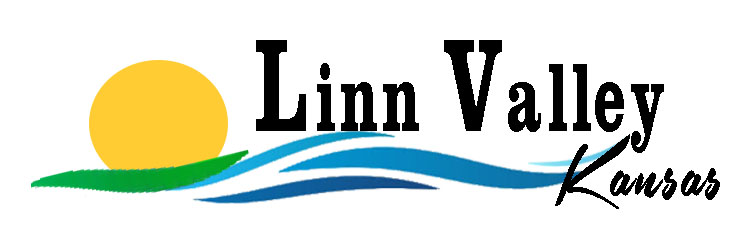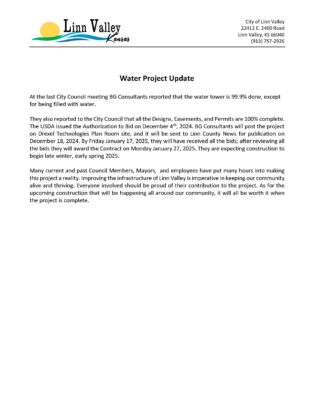10. Question: What happens when people are on a severely fixed income, and can’t afford to pay for the water line from the meter to the house?
Answer: It is a minimum of 18 months for the first property owners to be connected to enable property owners to plan for the expense and one of many reasons why the information is being provided in advance. All efforts will be made to help property owners on an individual basis.
9. Question: What is going to be the water meter fee?
Answer: The water meter fee has not been determined.
8. Question: I own lots in Area No 2 (red) (Linn Valley Water Project Map). What is the timeline for water connections in this area?
Answer: It is too early in the project to give specific dates for construction to start and the priority of areas. The areas on the map are not a priority listing, the areas are a depiction of work areas. Schedule of connections will be after a contractor is selected. The earliest construction of the project will be in 2020.
7. Question: I’ve received verbal quotes that I could be looking at $100 per foot to run water lines from the meter to my house. Will the city be working with the contractor for reasonable rates while in construction? And possible help with financing?
Answer: The City will make every effort to work with private contractors. Ultimately each resident is responsible for selecting their contractor. Residents are responsible for their individual financing and are likely a minimum of 2 years away to enable planning.
—–
6. Question: Will I be required to connect to the new waterlines, and if so who will cover the cost of the connection between the meter and the home?
Answer: The following residents will be required to connect to the new water system: all R1 (building lots) and all permanent residents on a R2 (multi-purpose or camping) lot. Temporary residents in campers on an R2 lot will have the option to connect to the City water system. Residents with metered water service (local or RWD#1) will not need a new connecting line. Residents that are on bulk water will be responsible for connecting lines from the meter to their home. Permanent and Temporary residency is defined in Ordinance #178.
—–
5. Question: Currently the existing water line is in the back (rear) of my home. Will the water line have to be moved?
Answer: Moving existing water lines will be done on an individual basis and is likely several years from determination. All efforts will be made to minimize moving existing reusable water lines and increasing costs.
—–
4. Question: Will I be required to decommission my existing water tank?
Answer: The Linn Valley City Council is not requiring the decommissioning of water tanks used for potable water.
—–
3. Question: Can I use my water tank as a storm shelter?
Answer: Residents and Property Owners can make decision on the disposition or re-purposing of their individual water tanks. The City recommends checking with the Public Safety Officer regarding the viability of using for a storm shelter on an individual basis.
—–
2. Question: During the public Water Meeting I heard that the average monthly water bill is $80, what is the rate structure?
Answer: The rate structure has not been determined by the City Council because the project is in an early phase. The next step is to apply for grant funding of the project.
—–
1. Question: Why can’t the existing water lines be “reused” and save money?
Answer: The majority of existing infrastructure will not support the water pressure for emergency flow and the pressurized fire hydrants. The scope of the project includes upgrading the infrastructure for the entire City to have consistent water flow and quality.


 Town Hall. Water & Wastewater Projects October 14, 2023
Town Hall. Water & Wastewater Projects October 14, 2023